
Cisticolas are a genus of very small insectivorous birds formerly classified in the Old World warbler family Sylviidae, but now usually considered to be in the separate family Cisticolidae, along with other southern warbler genera. They are believed to be quite closely related to the swallows and martins, the bulbuls and the white-eyes. The genus contains about 50 species, of which only two are not found in Africa: one in Madagascar and the other from Asia to Australasia. They are also sometimes called fantail-warblers due to their habit of conspicuously flicking their tails, or tailor-birds because of their nests.

The zitting cisticola or streaked fantail warbler is a widely distributed Old World warbler whose breeding range includes southern Europe, Africa, and southern Asia down to northern Australia. A small bird found mainly in grasslands, it is best identified by its rufous rump; in addition it lacks any gold on the collar and the brownish tail is tipped with white. During the breeding season males have a zigzagging flight display accompanied by regular "zitting" calls that have been likened to repeated snips of a scissor. They build their pouch nest suspended within a clump of grass.

The golden-headed cisticola, also known as the bright-capped cisticola, is a species of warbler in the family Cisticolidae, found in Australia and thirteen Asian countries. Growing to 9–11.5 cm (3.5–4.5 in) long, it is usually brown and cream in colour, but has a different appearance during the mating season, with a gold-coloured body and a much shorter tail. It is an omnivore and frequently makes a variety of vocalizations. Known as the "finest tailor of all birds", it constructs nests out of plants and spider threads. It mates in the rainy season. It has a very large range and population, which is thought to be increasing.

The neddicky, or piping cisticola, is a small passerine bird in the family Cisticolidae, which is native to Africa, southwards of the equator. Its strongholds are the light woodlands and shrublands of the subtropics and temperate regions of southern Africa. The common name, neddicky, is the Afrikaans name for the species.
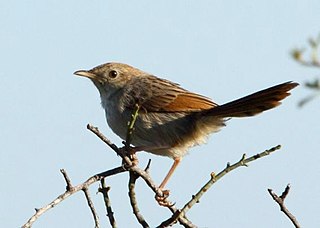
The grey-backed cisticola or red-headed cisticola is a small passerine bird. This cisticola is a resident breeder in southernmost Angola, Namibia and western South Africa.

Levaillant's cisticola, also known as the tinkling cisticola, is a small passerine bird which is native to marshlands in the uplands of Africa, southwards of the equator.

The chattering cisticola is a species of bird in the family Cisticolidae. It is found in Angola, Cameroon, Central African Republic, Republic of the Congo, Democratic Republic of the Congo, Equatorial Guinea, Gabon, Nigeria, and Sierra Leone. Its natural habitats are dry savanna and swamps.
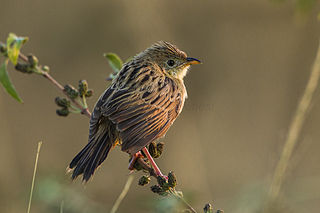
The wing-snapping cisticola, also known as Ayres' cisticola, is a species of bird in the family Cisticolidae. Its scientific name honours South African ornithologist Thomas Ayres.

The short-winged cisticola, also known as the siffling cisticola, is a species of bird in the family Cisticolidae. It is found in Angola, Benin, Burkina Faso, Burundi, Cameroon, Central African Republic, Chad, Republic of the Congo, Democratic Republic of the Congo, Ivory Coast, Eritrea, Ethiopia, Gabon, Gambia, Ghana, Guinea, Guinea-Bissau, Kenya, Liberia, Malawi, Mali, Mozambique, Niger, Nigeria, Rwanda, Senegal, Sierra Leone, Somalia, South Sudan, Tanzania, Togo, Uganda, Zambia, and Zimbabwe.
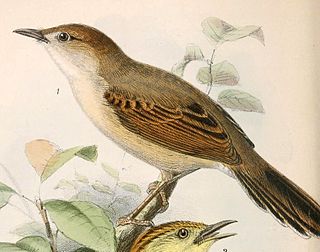
The singing cisticola is a species of bird in the family Cisticolidae. It is found in Benin, Burkina Faso, Burundi, Cameroon, Central African Republic, Chad, Democratic Republic of the Congo, Ivory Coast, Eritrea, Ethiopia, Gambia, Ghana, Guinea, Guinea-Bissau, Kenya, Liberia, Malawi, Mali, Mozambique, Niger, Nigeria, Rwanda, Senegal, Sierra Leone, Sudan, Tanzania, Togo, Uganda, Zambia, and Zimbabwe. Its natural habitats are subtropical or tropical dry forest and subtropical or tropical dry shrubland.

The rattling cisticola is a species of bird in the family Cisticolidae which is native to Africa south of the equator, and parts of East Africa. It is a common to abundant species in open savanna and scrubland habitats, whether in arid, moist or upland regions. Especially during summer, it is highly conspicuous due to its strident and repetitive call-notes from prominent perches.

Dorst's cisticola, also known as the plaintive cisticola, is a bird in the family Cisticolidae. It occurs in West Africa and south of Lake Chad.
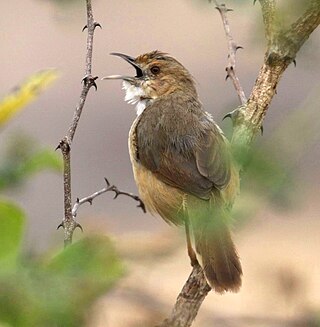
The red-faced cisticola is a species of bird in the family Cisticolidae. It is widely present across sub-Saharan Africa. Its natural habitats are subtropical or tropical seasonally wet or flooded lowland grassland and swamps.

The winding cisticola is a species of bird in the family Cisticolidae. It has a scattered distribution across Africa south of the Sahara, and north of 11°S.

The whistling cisticola is a species of bird in the Cisticolidae family. It is native to the African tropical rainforest and adjacent areas. Its natural habitats include subtropical or tropical dry forests, dry savanna, and moist savanna.

The chirping cisticola is a species of bird in the family Cisticolidae. It is found in Angola, Botswana, Burundi, Democratic Republic of the Congo, Namibia, Tanzania, Zambia, and Zimbabwe. Its natural habitats are subtropical or tropical seasonally wet or flooded lowland grassland and swamps.
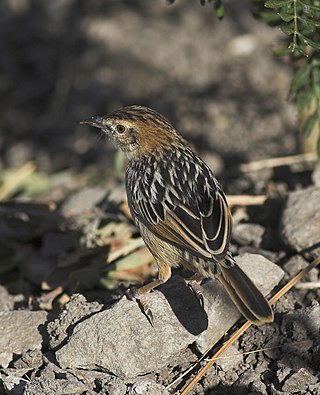
The stout cisticola is a species of bird in the family Cisticolidae. It is found in Angola, Burundi, Cameroon, Republic of the Congo, Democratic Republic of the Congo, Eritrea, Ethiopia, Kenya, Nigeria, Rwanda, South Sudan, Tanzania, Uganda, and Zambia. Its natural habitats are boreal forest, moist savanna, and subtropical or tropical high-altitude grassland.

The tinkling cisticola or grey cisticola is a species of bird in the family Cisticolidae. It is found in Angola, Botswana, Republic of the Congo, Democratic Republic of the Congo, Gabon, Malawi, Namibia, South Africa, Zambia, and Zimbabwe. Its natural habitat is dry savannah.

The Luapula cisticola is a species of bird in the family Cisticolidae. It is found in south-central Africa.

The rufous-winged cisticola is a species of bird in the family Cisticolidae. It is found on the east coast of southern Africa.





















